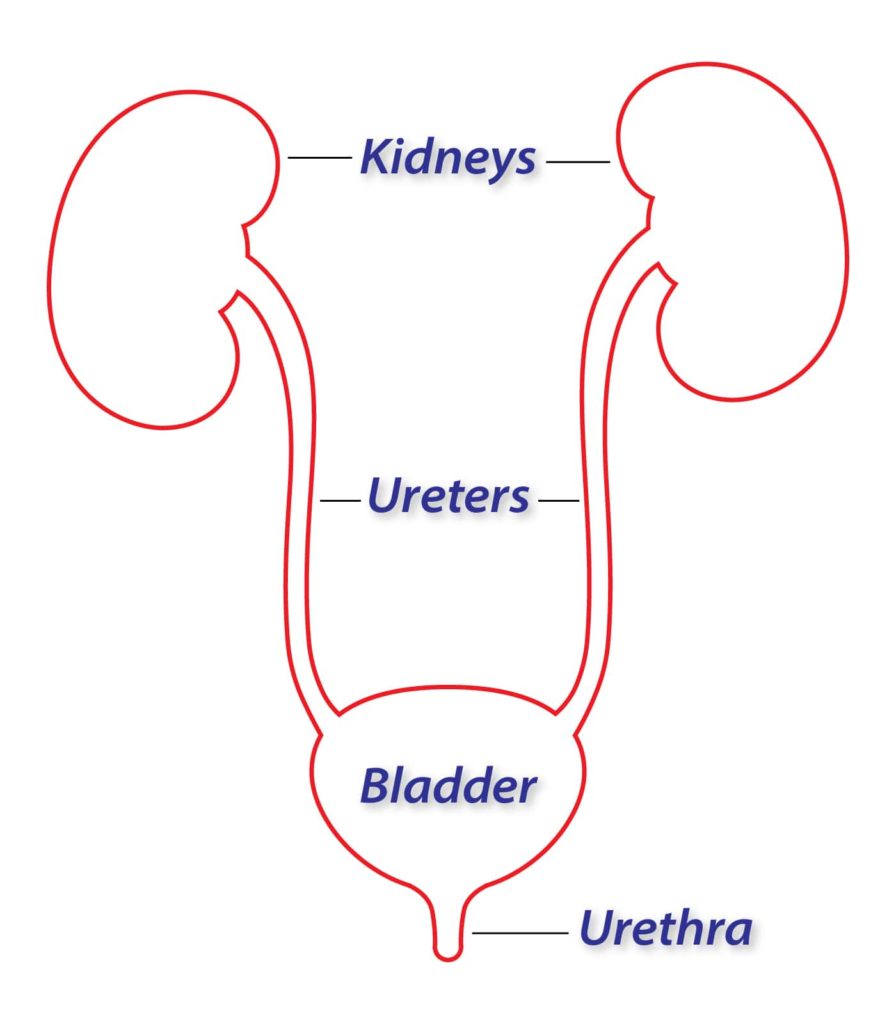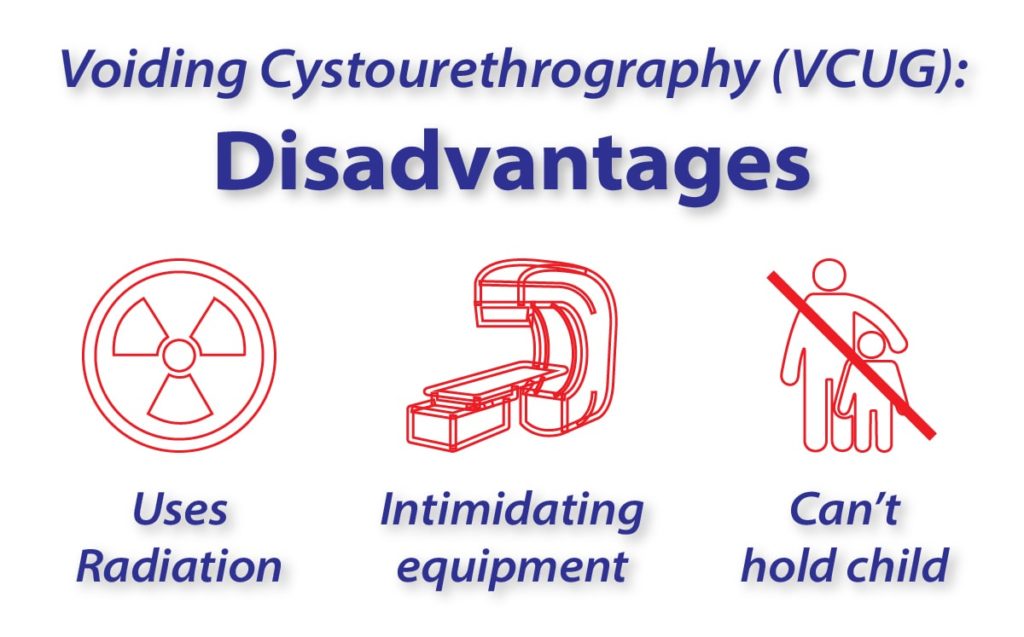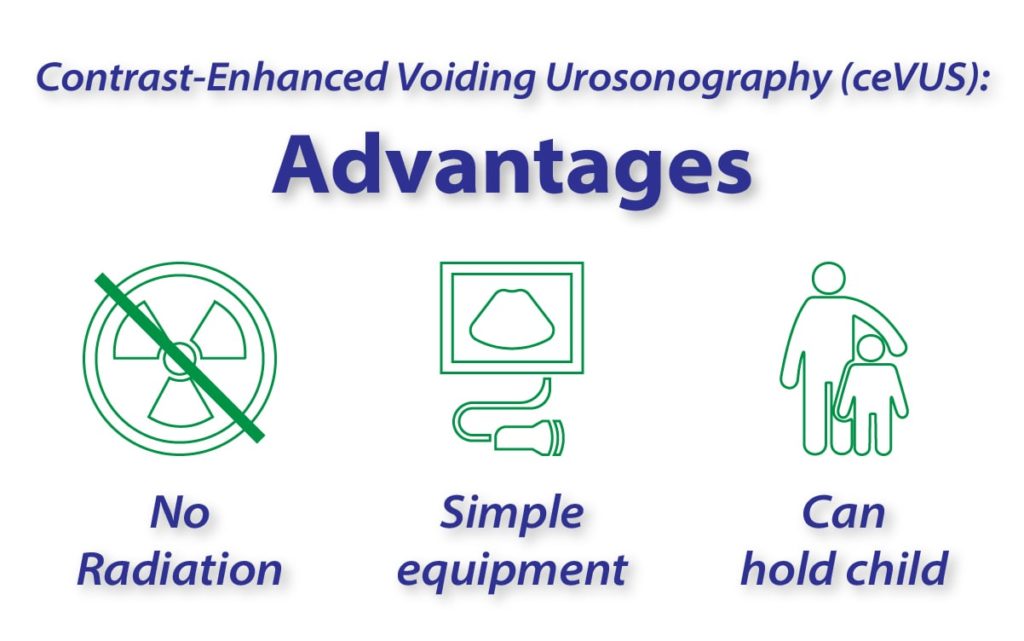A child or infant with frequent UTIs may need to be screened for vesicoureteral reflux (VUR). VUR is condition that causes urine to flow from the bladder back up into the kidneys. The standard procedure for diagnosing VUR is voiding cystourethropthy (VCUG), which uses x-rays. At UVA Radiology and Medical Imaging, we offer a new, radiation-free alternative: contrast-enhanced voiding urosonography (ceVUS).
What is vesicoureteral reflux (VUR)?

You’ve probably heard of acid reflux, which is when stomach acid flows back up into the esophagus and causes irritation. But did you know that reflux can happen in other places in the body, including in the urinary system?
The urinary system includes two kidneys, which are fist-sized organs that filter liquid waste and blood. Two tubes called ureters carry urine from each kidney to the bladder. The bladder stores urine until it passes from the body through another tube called the urethra.
Vesicoureteral reflux (or VUR) is a condition in infants and young children caused by a defect or blockage in one or both ureters. This defect allows urine to flow from the bladder back up into the kidneys. Some children are born with this defect; for others, a blockage can develop over time.
Children With Frequent UTIs: When to Screen for VUR
Often, VUR has no symptoms and children grow out of it. But some children with VUR develop urinary tract infections (UTIs). There is a risk of those infections spreading to the kidneys or putting pressure on them. A child with VUR who has frequent UTIs can have long-term problems including high blood pressure and kidney damage.
If your child has symptoms of a UTI, they may need to be screened for VUR. Frequent UTIs in children under 5 (and in boys at any age) are uncommon and may be a sign of VUR. Symptoms of a UTI include a fever, pain while urinating, the need to urinate a lot, or pain in the lower belly. Babies with UTIs may have a fever, may throw up, and may be fussy.
Standard Screening Procedure: Voiding Cystourethrography (VCUG)
The standard screening procedure for VUR is voiding cystourethrography (or VCUG). This procedure uses x-rays, or radiation, to create images of the bladder and urethra while a child’s bladder is full and while a child urinates.
For this exam, a child lies on a table while a technologist inserts a catheter (a thin, flexible tube) through the urethra and into the bladder. The catheter insertion may be uncomfortable, but it is not usually painful.
Next, the technologist injects contrast dye into the bladder through the catheter. Contrast makes the bladder much more visible for the x-ray. The technician takes several x-rays from different angles using a large camera above the table. Then the catheter is removed and more x-rays are taken while the child urinates.

There are three main downsides to VCUG. First, VCUG exposes a child to radiation. During VCUG, a child could be exposed to as much radiation as 25-30 chest x-rays, though the amount is usually much less than that. Studies have shown that children exposed to radiation can have an increased risk of developing cancer later in life.
Secondly, the equipment needed for a VCUG is very large and must be positioned close to the child during the exam. That can be intimidating for young children.
Finally, caregivers are not able to hold their child or can only touch their child in a limited way during VCUG. This is because of the radiation and the size of the imaging equipment. This physical isolation can increase a child’s anxiety and fear during the procedure.
A Safer and More Comforting Alternative: Contrast-Enhanced Voiding Urosonography (ceVUS)
Contrast-enhanced voiding urosonography (or ceVUS) is a new procedure that uses ultrasound with contrast to image a child’s urinary tract.
During ceVUS, a child will have a catheter with a special ultrasound contrast solution inserted through their urethra, much like a VCUG. But instead of x-rays, this exam uses ultrasound to image the bladder and urethra.
Ultrasound is safe and painless, producing real-time images of the inside of the body using sound waves. It’s non-invasive, has no known side effects, and doesn’t use radiation.
Once the technologist injects the contrast into the child’s bladder, they place a small ultrasound probe on a child’s skin to collect images of the urinary tract (this is the same probe used for pregnant women during their prenatal ultrasound). Then the technologist removes the catheter and uses the probe to obtain images while the child urinates.

During ceVUS, a child is not exposed to any radiation and the equipment used is much smaller than what’s needed for a VCUG. Accordingly, caregivers are able to hold their child during the entire procedure, reducing the child’s fear and anxiety.
The contrast solution used during this procedure is comprised of microbubbles smaller than red blood cells. It allows the ultrasound to show more detail than a traditional ultrasound. This makes ceVUS as accurate as VCUG at detecting defects in the urinary tract. This contrast is safe for patients who have allergies to traditional x-ray and CT contrast. And it does not harm the kidneys like traditional contrast can.
Contrast-Enhanced Voiding Urosonography (ceVUS) at UVA
UVA Children’s is one of just a small number of children’s hospitals in the country that performs ceVUS procedures to diagnose VUR. We’re proud to offer this safer and more comforting screening option. If you think your child has frequent UTIs, talk to your care provider about screening your child at UVA Children’s.
Infographic Text – Voiding Cystourethrography (VCUG): Disadvantages
- Uses radiation
- Intimidating equipment
- Can’t hold child
Infographic Text – Contrast-Enhanced Voiding Urosonography (ceVUS): Advantages
- No radiation
- Simple equipment
- Can hold child



